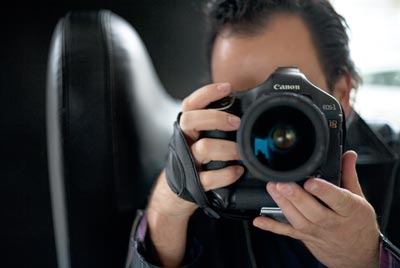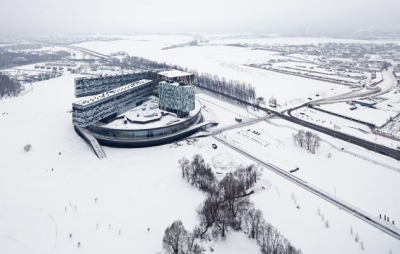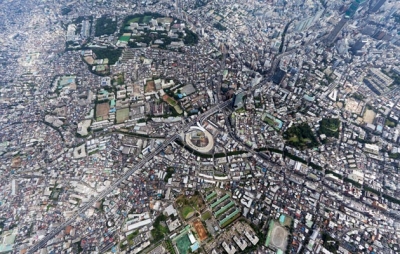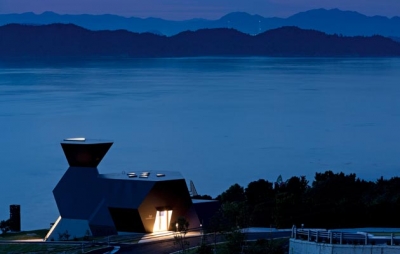|
Iwan Baan is a global nomad, restlessly travelling the world documenting new projects by the world’s most distinguished architects. Herzog & de Meuron, Rem Koolhaas and Steven Holl tell Icon why the ubiquitous Baan is their preferred photographer and explain how he looks at buildings in ingenious new ways Iwan Baan is having a busy week. Friday: Basel
Last year the globetrotting architectural photographer clocked up 190,000 air miles, living out of a suitcase and returning to his apartment in his native Amsterdam for only a day or two every other month. His unique style is much in demand by the world’s best architects, who realise that many will only see their buildings through Baan’s photographic record of them. He was in Basel shooting Herzog & de Meuron’s new Museum of Culture; he is travelling to New York to document the Lincoln Center for the Performing Arts for a book he’s working on with Diller, Scofidio + Renfro, the practice behind its recent redevelopment. Charles Renfro has said that Baan, 36, has “redefined the genre” of architectural photography, which traditionally presents buildings in their icy perfection, with blue skies and devoid of people. In contrast, Baan’s documentary style, as Steven Holl tells Icon, “captures the emotion and vibrating life of people in space with humour. They are the indeterminate, rather than determinate and frozen”. Holl adds: “Iwan Baan is more than a photographer, he is an unpredictable omnipresent force – his photos have zeal.” “Baan seems to be everywhere,” Herzog & de Meuron acknowledge. “Whenever a new building appears somewhere in the world, the image of it reaches you through the lens of his camera. His buildings are never alone. They come with people. The people tell us about the buildings they use. How they use them, why they use them, how it is to use them.” Pinning Baan down, in what he admits is an “insane travel schedule”, turns out to be a tricky proposition, involving multiple changes of plan. Icon’s photographer met him in Bilbao, where he was photographing a new park by Balmori Associates; I eventually caught up with him in Cartagena, Spain, where he was shooting a new auditorium by Selgas Cano Studio. Baan appeared with architect José Selgas, strolling down the palm-lined boardwalk that divides the building from the sea, his tripod slung over his shoulder. “At night the whole building becomes a big lantern,” Baan says of the striking 410m facade, made of corrugated plastic threaded with lines of fluorescent colour. Indeed, at dusk it glows like the neon spirit level on top of Baan’s Canon digital camera. I shadow Baan as he shoots: over 1,000 images that day. He is dressed in black, with a crisp shirt (courtesy of his hotel’s laundry service), and slips around the building with his small shoulder bag of equipment, taking pictures of the preparations for opening night. He is fascinated by how people behave in new spaces, exploring them with a sense of wonder he obviously shares. “There’s so much to discover,” he enthuses of the building. “All these wonderful details and the handmade quality of it all. To me this is sustainability, in a way, to do everything as lightly and economically as possible. They rethink everything in their buildings – nothing is standard. It’s like a huge collage.” I find myself trying to duck out of shot as Baan works, but I soon realise the absurdity of this attempt at erasure considering his distinctive style and ever-mobile lens. We’re all part of the cast of extras that populate his work, which has architecture as its backdrop: a dog pulling a man along on a bicycle, two joggers, a man on a phone, a woman lugging her shopping. Indeed, he enlists me to model a staircase when no-one else is around. “It’s like a beautiful line drawing,” he remarks of its striking zigzag silhouette. Baan is softy spoken, mild-mannered and quick to laughter. As a seasoned traveller, he is used to putting new acquaintances at ease without intruding on the hospitality his easygoing manner invites. Baan only came to architectural photography in 2005, when he wrote to Rem Koolhaas to suggest the architect use a method of 360-degree photography that he was pioneering to record an OMA exhibition. “Iwan Baan first came to us,” Koolhaas tells Icon, “because he had invented a technical process whereby he could insert a bullet into a building or a model and unfold it in a computer, so it was an exceptional way of making and experiencing a photograph. One of our most exciting collaborations was the transformation of an exhibit in a tent for the European Union into an experience on a very beautiful website. So from the beginning, I knew him as someone ingenious in finding new ways of looking at buildings.” When Baan proposed that OMA employ him to record the construction of its CCTV building in Beijing, Koolhaas accepted and, in an ongoing project, Baan has visited the site roughly every two months for the past six years. “What interested me,” Baan says, “were these people who come from the countryside to build something they’ve never seen or imagined before. They live there on the site where you see this thing rising and the rest of Beijing changing as well – everything going up, going down – it all goes so fast. People live almost in dorms on the site, there is an incredible sort of camaraderie around it, and you try to capture the feeling of it all.” Baan, who claims only an “intuitive” understanding of architecture, contacted other firms he admired to suggest he also document their projects. “We did not choose Iwan Baan,” say Herzog & de Meuron. “He chose us. He obviously decided to enter the world of contemporary architecture and he did it without being pushy and loud but with discreet, yet firm determination.” However, Baan explains that he’s interested in “stepping back from the architecture … in trying to get away from these buildings in a way, in placing them in a city, in a context”. He likes to charter helicopters to capture the bird’s-eye view, illustrating how a building moulds or is moulded by its environment, but the majority of his images zoom in on the people who adapt the city to themselves. His photographs are saturated with humanity. “Architects are control freaks,” Baan says, “and I think it’s very interesting also to show all these sorts of things which happen outside the grand idea … the perfect highways and the perfect plan form the air … to see how a place like that develops. How people find their way in any condition.” Baan uses his considerable accumulated air miles to pursue private projects in places like Africa and Columbia. A recent book of photographs on Oscar Niemeyer and Lúcio Costa’s Brasilia and Le Corbusier’s Chandigarh showed how modernist utopian projects have been adapted with pragmatism to real-life, and he is currently working on a volume about Caracas, which he describes as “a carpet of slums” when seen from the air. Baan photographed a tower in the middle of the city, left unfinished in the 1980s. “It was never completed because the economy crashed and the company went bankrupt,” he says, showing me images he’s taken. “It has now turned into the largest vertical slum, where people started designing their own living and public spaces inside this concrete shell without anything – no elevators, no running water, nothing. That fascinates me, how an architect comes up with something but then how it changes over time.” I ask Baan whether his itinerant life is a lonely one. “It is a little bit crazy,” he shrugs, “but I get to do what I like to do and it is the only way I can.” He has, he says, no attachments, and has accumulated pockets of friends around the globe. His phone seems to buzz constantly, overflowing with emails and text messages, and he pauses to take multiple calls (he arranges his own flights, itinerary and fees, and travels on the hoof, booking planes at the last minute and sorting hotels on arrival). “Every other night it’s a new opening,” he says, claiming that, in a way, he is almost always on holiday. That evening the Japanese pianist and composer Ryuichi Sakamoto plays to a packed house of 1,500 people to open Selgas Cano’s new auditorium. Baan doesn’t have a seat, but moves quietly between tiers, taking pictures during moments of applause. The next morning Selgas drops Baan and me at the airport in his 1967 Citroën DS and Baan takes his leave. He’s meeting a pilot who is going to fly him over the concert hall in a two-seater plane so that he can photograph it from the air (the nearby Nato base made it difficult to get permission to hover above it in a helicopter). He’s already climbed a nearby mountain to shoot it, and photographed it from a crane that unloads shipping containers in the nearby dock. Tomorrow he will shoot the building from the water. “It’s a shame you can’t stay longer,” he says. “We’re going out in a yacht, and it must be quite big because they say I can climb to the top of the mast to take photos.” He pauses and adds: “It’s not such a hard life.”
|
Words Christopher Turner
This article was first published in Icon’s January 2012 issue, which looked back over the year 2011, under the headline “Man of the moment”. Buy back issues or subscribe to the magazine for more |
|
|
|
2012: A year in pictures
|
||
|
Francis Kere, Centre for Earth Architecture, Mali
Steven Holl, CIPEA Museum of Contemporary Architecture, Nanjing
David Adjaye, SKOLKOVO Management School, Moscow
Selgas Cano, Factoría Joven, Merida
Baku, Azerbaijan
Diller, Scofidio + Renfro, High Line, New York
Tokyo
Todd Saunders, Fogo Island, Newfoundland
OMA, Seattle Public Library, Seattle
OMA, Milstein Hall, Cornell University, Ithaca
OMA, Maggie’s Centre, Gartnavel
Toyo Ito, Toyo Ito Museum of Architecture, Omishima
|
|
|































